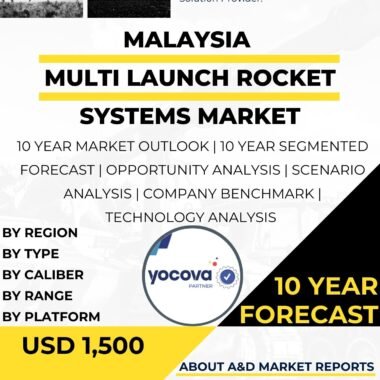Description
The China Multiple Launch Rocket System (MLRS) market has experienced significant growth and development in recent years. With China’s focus on modernizing its military capabilities and strengthening its artillery forces, there has been a substantial demand for advanced MLRS systems. This market analysis provides an overview of the China MLRS market, including key players, market drivers, challenges, and future prospects.
The China MLRS market is characterized by the presence of both domestic and international players. Domestic companies, such as Norinco Group and China Aerospace Science and Industry Corporation (CASIC), have made significant contributions to the development, production, and deployment of MLRS systems. These companies have invested in research and development to enhance the capabilities of their systems and meet the specific requirements of the Chinese market.
International players, including renowned manufacturers such as Lockheed Martin, Hanwha Corporation, and Roketsan, have also established a presence in the China MLRS market. Collaborations between domestic and international players have been observed, leveraging their respective strengths in technology development, manufacturing, and market reach.
The market is driven by several factors. One of the primary drivers is China’s need to enhance its artillery capabilities and achieve a greater range and firepower. MLRS systems provide a highly effective means of delivering a large volume of firepower to the battlefield in a short period. The ability to launch multiple rockets simultaneously from a single platform significantly enhances the offensive capabilities of military forces.
Technological advancements have played a crucial role in the growth of the China MLRS market. Domestic companies have focused on developing indigenous MLRS systems with improved range, accuracy, and lethality. China has made significant progress in developing various MLRS systems, including truck-mounted systems, towed systems, and self-propelled systems.
Truck-mounted MLRS systems, such as the PHL-03 and PHL-16, have been successfully developed and deployed by China. These systems offer the advantages of mobility and rapid deployment, making them highly effective in supporting maneuvering forces. Towed MLRS systems, such as the AR3, provide greater flexibility and can be easily transported to various locations. Self-propelled MLRS systems, such as the AR1A, combine mobility with firepower, offering enhanced operational capabilities.
Another driver of the China MLRS market is the export market. China has emerged as a significant exporter of MLRS systems, offering cost-effective solutions to countries seeking to enhance their artillery capabilities. The Belt and Road Initiative (BRI) has provided opportunities for China to export its MLRS systems to partner countries, expanding its market presence globally.
However, the China MLRS market also faces certain challenges. One of the primary challenges is the need for continuous research and development to keep pace with evolving battlefield requirements and emerging technologies. As adversaries develop more advanced countermeasures and seek to neutralize MLRS systems, China must invest in innovation and advanced technologies to maintain its technological edge.
Additionally, the market faces challenges related to international export restrictions and intellectual property rights. The development and export of MLRS systems are subject to strict regulations due to security concerns. This can limit market opportunities and hinder collaboration with international partners.
Looking ahead, the future prospects for the China MLRS market are promising. China’s commitment to military modernization and indigenous defense capabilities will continue to drive investments in MLRS systems. Ongoing research and development efforts, collaborations between domestic companies and international partners, and the integration of emerging technologies are expected to result in the introduction of more advanced and capable MLRS systems.
The integration of technologies such as artificial intelligence (AI) and autonomous systems may shape the future of the market. AI-powered MLRS systems can improve targeting accuracy, reduce collateral damage, and enhance overall operational efficiency. The development of autonomous MLRS systems that can operate in complex and dynamic environments will further strengthen China’s artillery capabilities.
In conclusion, the China MLRS market has witnessed significant growth driven by the country’s focus on military modernization and strengthening its artillery forces. Technological advancements, collaborations between domestic and international players, and the government’s commitment to indigenous defense capabilities have contributed to the development and deployment of advanced MLRS systems. Challenges related to evolving battlefield requirements and export restrictions need to be addressed. With ongoing research and development, collaborations, and the integration of emerging technologies, the future of the China MLRS market looks promising, with opportunities for further growth, innovation, and advancements in MLRS systems.




